Comptroller Kevin Lembo Archive > News
COMPTROLLER LEMBO SAYS DEFICIT MITIGATION MEASURES PUT STATE ON PATH TO $200,000 SURPLUSComptroller Kevin Lembo reported today that, after adjusting for the deficit mitigation requirements adopted by the General Assembly in December, the state is on track to end the current fiscal year with a small General Fund surplus of $200,000.
In a letter to Gov. Dannel P. Malloy, Lembo said this projection takes into account Public Act 15-1, which implements $214.3 million in spending reductions and $135.8 million in revenue enhancements.
Lembo said General Fund revenues are estimated to close the fiscal year $81.7 million below the budget plan – with the largest revenue reduction to the income tax, which has been revised down by $189.4 million due to slow wage growth and stock market volatility.
Last fiscal year (Fiscal Year 2015), 44 percent of total estimated income tax payments were collected in December and January. Therefore, additional data will become available through January on the revenue impact of the August stock market downturn on income tax receipts. Updated consensus revenue forecasts – which could influence this year’s projection – are due on Jan. 15.
Meanwhile, General Fund spending is expected to fall $281.7 million below initial budget expectations.
"While the state has been adding jobs at a consistent pace since the middle of 2014, wages have not rebounded at the rate experienced during other periods of sustained employment growth,” Lembo said. "The slow advance in wages has been attributed to the composition of job growth by employment sector, with lower paying sectors adding the most jobs, and to slow growth in worker productivity. Connecticut, like many other states, is likely to continue to experience significant budget pressure until both employment and wages return to normal expansionary growth patterns.”
As Lembo has noted repeatedly, this economic recovery has been unlike past post-recession recoveries – and demands that Connecticut use this experience as an opportunity to adopt measures that ensure greater predictability.
"During this period of reinvention, we must build more predictability into our budget and revenue assumptions,” Lembo said. The Budget Reserve Fund reform that Lembo proposed, and was adopted by the General Assembly earlier this year, will help achieve more revenue stability and budget predictability – however, it will not be effective until 2020.
Lembo pointed to some of the latest economic indicators from federal and state Departments of Labor and other sources that show:

• Through November, as seasonal employment was increasing, year-to-date
income tax withholding receipts were running 2.3 percent above the same period
last fiscal year. In October year-to-date withholding was up 1.4 percent. New
tax rate tables incorporating the higher rate structure, as adopted in PA
15-244, were required to be implemented by the end of August. Therefore,
beginning in of September 2015 receipts have incorporated the higher tax rates.
• Withholding receipts are the largest single source of state tax revenue,
accounting for 61 percent of the total income tax receipts in Fiscal Year 2015
and almost 40 percent of total General Fund tax receipts in that year. As can be
seen from the graph below, with the exception of the increases experienced in
Fiscal Years 2011 and 2012 that resulted from tax increases, withholding growth
has been well below normal post-recession levels.
• For the single month of November, withholding receipts were 6.2 percent above
last November’s collections.

• According to the Department of Labor, preliminary November nonfarm
employment estimates from the U.S. Bureau of Labor Statistics (BLS) payroll
survey (seasonally adjusted) indicated that Connecticut gained 5,100 jobs in
November, bringing payroll employment to a level of 1,699,700. October’s
original estimate of 2,200 job losses improved slightly to a loss of 1,700 jobs.
Connecticut is now estimated to have added 26,800 nonfarm positions over the
last 12 months, which is a fairly typical gain during a period of moderate
economic expansion.
• Connecticut has now recovered 105,700 positions, or 88.8 percent of the
119,000 seasonally adjusted total nonfarm jobs that were lost in the state
during the March 2008 - February 2010 employment downturn. The state needs to
reach the 1,713,000 job level to enter a full nonfarm employment expansionary
phase. This will require an additional 13,300 jobs. Connecticut’s nonfarm jobs
recovery is now 69 months old and is averaging 1,532 new positions per month
since February 2010. Connecticut’s private sector has recovered all of its
recessionary employment loss, although with a different employment distribution
by sector than before the recession.
• The financial services sector pays wages that are more than 50 percent above
the statewide average for all sectors. But the financial services sector remains
14,900 jobs below its pre-recession level, and 23,900 jobs below its 1990 level.
At the same time, the leisure and hospitality sector that pays wages that are 46
percent below the statewide average for all sectors has added 20,900 jobs to its
pre-recession level and is up 49,100 jobs since 1990.
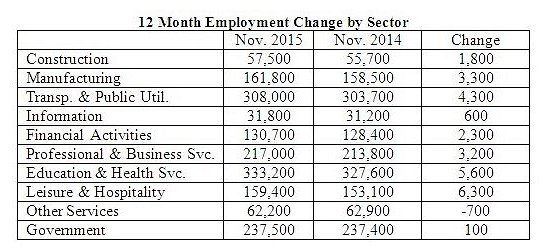
• U.S. employment has been advancing at a rate of 1.9 percent over the
12-month period ending in November; Connecticut’s employment growth was 1.6
percent for the same period.
• Connecticut’s unemployment rate was 5.1 percent in November; the national
unemployment rate was 5.0 percent. Connecticut’s unemployment rate has continued
to decline from a high of 9.5 percent in October 2010.
• There were 96,500 unemployed job seekers in Connecticut. A low of 36,500
unemployed workers was recorded in October of 2000. The number of unemployed
workers hit a recessionary high of 177,200 in December of 2010.
![]()
• The Department of Labor reports that average hourly earnings at $29.82, not
seasonally adjusted, were up $1.16, or 4.0 percent, from the November 2014
estimate. The resulting average private-sector weekly pay was calculated at
$1,010.90, up $30.73, or 3.1 percent higher than a year ago.
• The 12-month percent change in the Consumer Price Index for All Urban
Consumers (CPI-U, U.S. City Average, not seasonally adjusted) in November 2015
was 0.5 percent.
• The graph below shows the monthly percent change from the prior year in
Connecticut private-sector weekly earnings. Connecticut and the nation as a
whole have struggled with stagnant wage growth. This graph provides monthly data
through November of 2015.
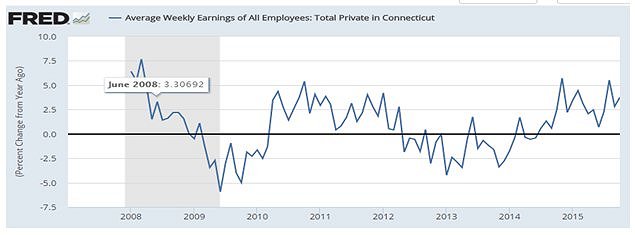
• One reason for the slow growth in statewide wages during this recovery has
been the distribution of job gains by sector. As discussed above, the financial
services sector has not returned to its pre-recession employment numbers; while
the leisure and hospitality sector has far exceed its pre-recession job totals.
• The graphs below show the wage and trend differentials of the two sectors with
the financial service sector wages four times higher than those of leisure and
hospitality.
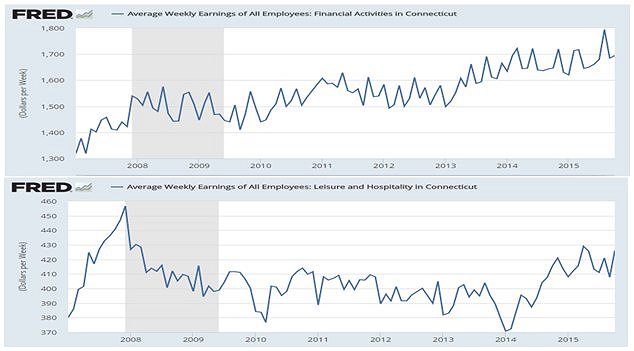
• Based on third-quarter data from the Bureau of Economic Analysis released on Dec. 21, 2015 Connecticut ranks 27th nationally in income growth for the quarter. The chart below shows the 12-month trend in Connecticut personal income, which has yet to attain its past expansionary strength.
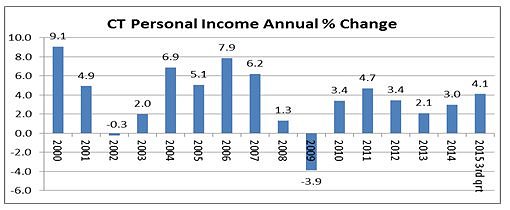
• Per capita income does not provide information on income distribution or
relative income inequality. A report issued by the Economic Policy Institute in
2015 stated that New York and Connecticut had the largest gaps between the
average incomes of the top 1 percent and the average incomes of the bottom 99
percent. In both states, the top 1 percent earned average incomes more than 48
times those of the bottom 99 percent.
• Nationally, a study by the Pew Research Center found that the middle class has
been shrinking since the 1970s as the graph below depicts.
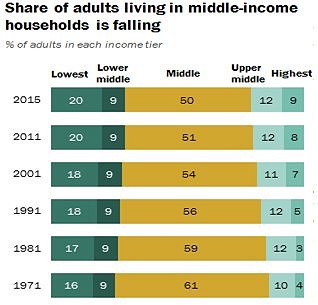

• According to a Dec. 3, 2015 release by the Warren Group, October single family
home sales in the state increased 9.2 percent from the prior year’s October.
This was the highest October single-family sales number since 2006. However, in
October 2006 the median price of a single-family home in the state was $276,600.
In October 2015 that price was $235,000, down 2.1 percent from October 2014 and
down 16.8 percent from 2006. Condominiums have followed a similar pattern of
rising sales numbers, but falling prices.
• According to a report by the Partnership for Stronger Communities, despite
falling home prices, the supply of housing that is affordable and available to
working-class households continues to fall well short of demand, particularly in
locations where high-resource schools, jobs and abundant services are available.
As a result, half the state’s renters and 34 percent of its homeowners are
paying 30 percent or more of their income for housing. The percentage of
households renting has increased from 30 percent in 2007 to 34 percent in 2014.
Consumers
• According to the Commerce Department, U.S consumer spending increased 0.3
percent in November after an essentially flat reading in October and a
0.2-percent gain in September. Spending on goods climbed 0.6 percent, driven by
purchases of long-lasting items like cars and refrigerators. Spending on
services grew 0.2 percent.
• The Federal Reserve cited steady household spending growth as a factor in its
decision to raise interest rates this month for the first time in a decade.
• The personal saving rate edged down to 5.5 percent of after-tax income in
November compared to 5.6 percent in October. The personal savings rate has been
on a general downward trajectory over the past 50 years.
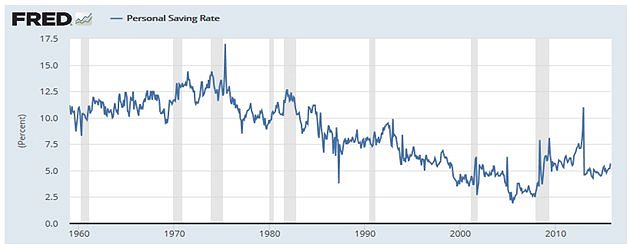
• The University of Michigan's consumer sentiment index rose in December to its highest level since July. Americans are responding positively to persistently low prices as inflation remains below 1 percent. They are more optimistic about their inflation-adjusted incomes than at any time since 2002. There are also some early signs that wage growth may begin to accelerate in 2016.
Business and Economic Growth
• According to the Dec. 22 third estimate by the Bureau of Economic Analysis,
GDP increased at an annual rate of 2.0 percent in the third quarter of 2015. In
the second quarter, real GDP increased 3.9 percent.
• The deceleration in real GDP in the third quarter primarily reflected a
downturn in private inventory investment and decelerations in exports in
personal consumption expenditures, in nonresidential fixed investment, and in
state and local government spending that were partly offset by a deceleration in
imports.
• The GDP growth rate has not attained a 3-percent level for a full calendar
year reporting period since the end of the recession. Based on present trend,
GDP growth will remain below the 3-percent level in 2015.
• Corporate profits dropped 1.6 percent in the July-to-September period and were
down 5.1 percent from a year earlier, the weakest annual reading since the final
months of the recession.
• The drop largely reflects pressure on U.S. corporations’ overseas operations
due to a stronger dollar and weak global demand. And contrary to conventional
wisdom, net income is declining both with and without energy companies.
• The Department of Labor produces the chart below, which tracks the ups and
downs in key Connecticut business indicators. The indicators tracked include
housing permits, Connecticut exports, average weekly wages, the Manufacturing
Production Index, air passenger count, weekly manufacturing hours, visits to
major attractions, and gaming slot activity. The index has shown improvement in
2015.

Stock Market
• Estimated and final income tax payments account for approximately 40 percent
of total state income tax receipts. These payments show a correlation to
activity in equity markets relating to capital gains.
• In Fiscal Year 2015, 44 percent of total estimated payments were collected in
December and January. So by the end of January, additional data will be
available on the revenue impact of the August stock market downturn.
• According to a recent report released by the Federal Reserve, Americans lost
nearly $1.2 trillion in wealth in the third quarter as the stock market dropped.
This equity decline contributed to one of the largest losses in household net
worth since the economic recovery began. To put the loss in perspective, in the
third quarter total real GDP was $16.4 trillion.
• Corporate equities lost $2.3 trillion over the quarter. Major stock indexes in
the U.S. plunged sharply in late August. In the fourth quarter, stocks have
regained most significant ground, so the decline in net worth may prove
fleeting.
• Estimated income tax receipts increased 5.3 percent in Fiscal Year 2015
compared to the prior fiscal year. Through November estimated receipts for
Fiscal Year 2016 are running 6.2 percent above last fiscal year.
• Over the past several years, the state has experienced significant
fluctuations in capital gains related receipts. In late 2012, investors turned
over a large volume of long-term capital gains to take advantage of the expiring
15-percent tax rate, which increased to a top long-term rate of 23.8 percent
(20-percent rate plus 3.8 percent on AGI above $200,000 related to the ACA) on
January 1, 2013. As a result, the state realized a windfall on the capital gains
driven portion of the income tax in Fiscal Year 2013. Because this left little
in unrealized gains, this component of the income tax experienced a sharp drop
in Fiscal Year 2014. As the market surged, investors were reluctant to take
short-term gains because such gains are taxed at the higher ordinary income
rate.
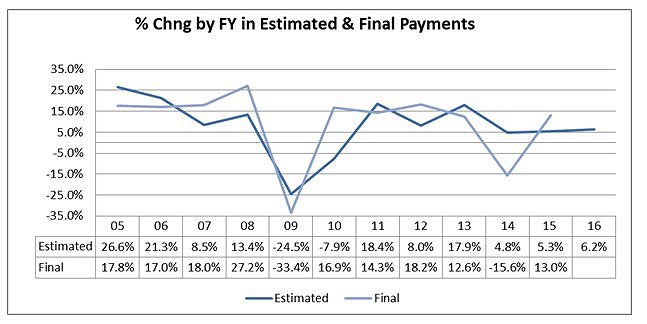
• The graph below shows the market activity and recovery in the Dow over the
year to date. At this writing the Dow is slightly down for the year.

download release as a PDF
***
***END***
